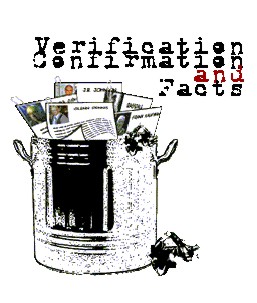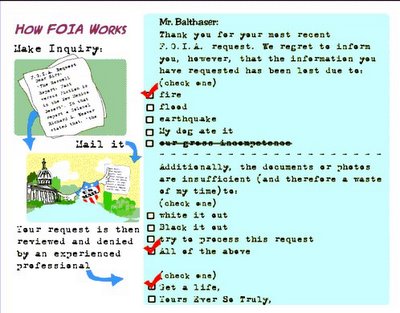|
|
|
Bond, during your recent visit to Roswell for the
first time (April 27-29, 2001), I had planned an in-depth interview with
you, pertaining to your involvement in the 1947 Roswell Incident. Due to
time constraints however that was not possible, so you agreed to answer
some questions via an email interview. I know you have answered many of
these questions before, but for my own benefit and others interested in
the subject, I would like to officially have some points cleared up.
The questions or statements listed below are based primarily on |
If any of the information I present below is incorrect please correct me, as my desire remains to obtain true statements and information. There will be no order to the questions or statements asked, but rather an accumulation of many concerns I have pertaining to the facts surrounding the Roswell Incident.
I have one request as you answer the questions below. I am asking that you rely completely on your own knowledge and memory of the events that transpired 50 some years ago. I am not interested in answers based on anyone else other than you personally. I anticipate and appreciate your candor in answering the questions.
DGB: Your career has included being a Consulting & Clinical Psychologist, United Methodist Pastor, staff reporter and part time photographer for the Fort Worth Star-Telegram newspaper, and a U. S. Army Colonel. Please briefly explain your military career as to dates of service, job description, and particularly your military status in July 1947, while working for the newspaper in Fort Worth.
JBJ: In July 1947 I was a pilot officer in the Civil Air Patrol, an auxiliary of the U. S. Air Force, and an enlisted member of the U. S. Marine Corps Reserve. I had joined the Army Air Forces on 15 Jan 1944 at age 17 during World War II for pilot training. I was discharged on 29 Oct 1945 after the surrender of Germany and Japan. At the time of VJ Day, 14 Aug 1945, I was engaged in Liaison Pilot training at Sheppard Field, Texas, aimed at the impending invasion of Japan. Since there were as yet no helicopters available our mission would have been to launch our small L-5 liaison aircraft from jeep aircraft carriers (actually LSTs with the superstructure removed) and land on pontoons on the sea, taxi onto the beach and load casualties. Then we were to fly seaward to land on the water and taxi alongside Navy hospital ships for removal of the injured; then to repeat the operation as required. The abrupt end of the war after the atomic bombing of two major cities in Japan fortunately averted the need for this operation. Our flight training was suspended the next day after VJ Day. I think it would not be too dramatic to speculate that the dropping of the atomic bombs on Japan likely saved my life.
Earlier, during a delay in flight training, I was assigned as an interviewer for an EE (escape and evasion) flight crew returnees interrogation operation. This sparked an early interest in psychology and study of human behavior.
I enlisted in the U. S. Marine Corps Reserve in July 1946 and was commissioned in 1948. I was recalled to two years active duty during the Korean Conflict and after completion of infantry officer basic training at Quantico served as a public information officer in the rank of captain; I also served as additional duty as a chaplain at Marine Corps bases. Normally the Marines are provided with Navy chaplains but there was a shortage during the Korean War and I was invited to serve in that capacity, which I was glad to do since I was an ordained minister and had served three churches as a pastor in Texas.
In 1963 I transferred to the 40th Armored Division, California National Guard, as a chaplain and later served in Army strategic psychological operations assignments -- twice in Europe and twice in the Pacific as well as in the United States. I served four tours of duty at the Pentagon on the Army Staff and Joint Staff and as a consultant in strategic PSYOP to the National Security Council at the White House during two administrations. General Al Haig was my boss there and I later worked directly for him on special classified military assignments in Europe while he was NATO military commander.
I also was a consulting faculty member in psycho-political strategies at the U. S. Army Command and General Staff College at Fort Leavenworth, KS, and for 11 years was a faculty member at the Army Special Warfare School at Fort Bragg, NC and also at Fort MacArthur, CA. For three years I was founding director of the Army Reserve PSYOP Department at Fort Bragg. I retired from the Army in the grade of colonel 43 years after first enlisting.
DGB: You have indicated that you purchased your own 4"x5" Speed Graphic camera and used it for other newspaper work you were assigned to such as police stories. Why were you selected to go to Ramey's office to take the photographs since photographer wasn't your primary duty with the newspaper?
JBJ: This is described rather fully in a similar online interview at Roswell Crash Photographer . If you still have any additional questions please address them to me.
DGB: To the best ability that your memory permits; who told you to go to Ramey's office; for what purpose were you going there? What were you doing at the time you were told to go?, and how did you go and how long from the time being told until you arrived at Ramey's office?
JBJ: I was assigned by my city editor, Cullum Greene. He simply came to my desk in the city room of the Star-Telegram and asked if I had my camera available. As far as I can recall this was the very first time that I had been specifically assigned to cover a spot news story as a photographer. I believe that I had purchased the camera in April, 1947, just three months prior to the Roswell Incident in July, 1947. Normally I used the camera to photograph events where I was engaged as a reporter, usually speakers at evening dinners or for police reporter breaking stories.
I drove to the air base in my nearly new 1947 Ford club coupe. I went immediately after being assigned to take the Ramey office pictures. The strongest recollection that I have is the extreme urgency involved in getting the Roswell crash photos. My city editor was quite concerned when he had just received a "flash" AP teletype alert message that a "captured" flying saucer was being flown from the Roswell Army Air Forces Base to the Eighth Air Force headquarters of General Roger Ramey located at Fort Worth Army Air Field and he was very eager to obtain photos of the craft. He underscored that we were close to photo deadline for East Coast newspapers and that I should go out and get the photos as quickly as possible and return to the office to process them. I recall that there were four other photographers who worked for the Morning Star-Telegram. I assumed then and now that I was the only photographer available at that moment even though I normally was assigned as the military editor for the Star-Telegram.
—As a young man, Dennis Balthaser [now retired 2022] would look into the night sky and wonder at the secrets it held. Some years later Dennis bought a book about UFOs and his wonder turned to investigation. Today he has a library with over 90 books in reference to ufology.
Dennis served 3 years ('59-62) with the United States Army in the 815th Engineering Battalion.
After some 33 years in Civil Engineering, Dennis retired from the Texas Department of Transportation in 1996. Having been keenly interested in the Roswell Incident of 1947, Dennis decided to move to Roswell, New Mexico, to pursue his avocation: Ufology.
Initially Dennis worked as an Engineering Consultant in Roswell, volunteering his time at the International UFO Museum and Research Center on weekends. Nine months later he resigned from the engineering firm, assuming the duties of IUFOMRC Operations Manager, served on the Board of Directors and became the UFO Investigator for the Museum, as a full time volunteer.
Due to his love of ufology, his dedication and his exhaustive work, Dennis is regarded as a leading investigator and ufologist by his peers, communicating regularly with such well known researchers as Stanton Friedman, Donald R. Schmitt, Wendy Connors, and others in their quests to find the truth.
Currently, in that Dennis is no longer affiliated with the Museum, he is able to devote his full time as an independent researcher/investigator to the Roswell Incident, Area 51 and underground bases research, and frequently lectures on these and other topics, related to ufology.
Dennis is a Certified Mutual UFO Network Field Investigator, a member of Great Pyramid of Giza Research Association, and belongs to several ufology organizations.






No comments :
Post a Comment
Dear Reader/Contributor,
Your input is greatly appreciated, and coveted; however, blatant mis-use of this site's bandwidth will not be tolerated (e.g., SPAM, non-related links, etc).
Additionally, healthy debate is invited; however, ad hominem and or vitriolic attacks will not be published, nor will "anonymous" criticisms. Please keep your arguments/comments to the issues and subject matter of this article and present them with civility and proper decorum. -FW